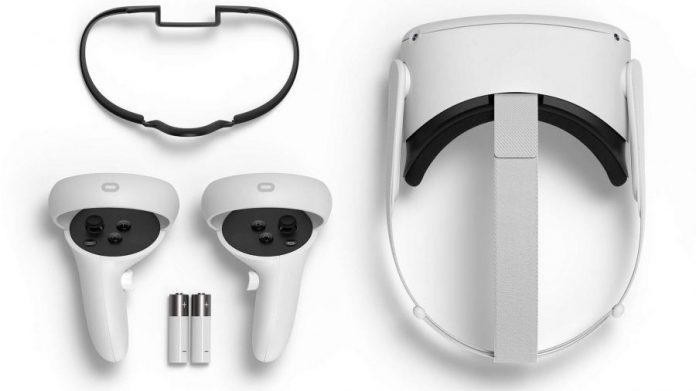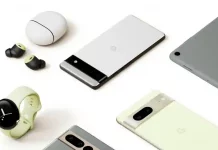It’s certainly disappointing to expect the Quest 3 to launch as late as that, given Meta’s clear appetite to establish itself as the home of mainstream VR gaming, but with the potential for clashes between its own hardware releases now a genuine reality, the company will likely put some distance between the two products.
That 2023 prediction was recently corroborated by analyst Brad Lynch, who tweeted (below) that the Oculus Quest 3 will be shown off during a 2023 Meta Connect event. If the company sticks to its annual event timetable, that means we could be playing the Quest 3 by October 2023.
Still, with the Quest 2 launching in October 2020, only a year and a half after the original, there’s a chance that the Quest 3 could follow a similar timeline – and analyst predictions should always be taken with a hefty pinch of salt.
The signs are promising, too, and more information is being revealed about the next Quest device as the months roll on. In a 2021 interview with The Information, Zuckerberg not only confirmed that the Quest 3 is definitely in the works, but that the company is already in the early stages of work on the Quest 4.
“Because of how hardware gets developed, you kind of need to know what your next three products are going to look like all at the same time,” Zuckerberg said.
“It’s not like software, where we’re changing it every couple of weeks. We have product teams spun up now working on the next few generations of virtual reality and what Quest 3 and 4 are gonna look like.“
Although there’s a big difference between actually creating these products and defining what they’re “gonna look like”, this is good news for those who are keen to find out more about the Quest 3.
It’s not all sunshine and rainbows, though. In April 2021, details were shared of a recent online chat between two key Oculus executives who suggested its next device is more likely to be an incremental Oculus Quest 2 Pro upgrade rather than a full-on Oculus Quest 3 follow-up – but again, this may have been in reference to the aforementioned upgraded Quest 2, or indeed the recently-announced Project Cambria. Meta hasn’t been super clear, either way.
All things considered, then, our best guess for an accurate Oculus Quest 3 release date is late 2023.
OCULUS QUEST 3 SPECS AND FEATURES
Given the improvements made by the Quest 2 over its predecessor, we’d expect the Quest 3 to remain a standalone VR headset with customary improvements to battery life, processing power, and resolution.
The Quest 2 boasts a 50% sharper picture than the original device, which sets an impressive benchmark for the Quest 3 to follow. The Quest 2 also upped the refresh rate to 90Hz from the original Quest’s default 72Hz and increased that figure again to 120Hz in 2021.
It would follow, then, that the Quest 3 will come equipped with a minimum refresh rate of 120Hz, although time will tell whether upcoming VR titles can take full advantage of the upgrade, given that most games still don’t yet support that higher refresh rate.
Interestingly, the aforementioned tweet from analyst Brad Lynch suggests the Quest 3 will include uOLED displays (an upgraded version of OLED). So, while nothing is official just yet, Meta’s next Quest headset is almost certain to push the boundaries of visual fidelity.
What’s more, a Swiss VR tech manufacturer, CREAL, last year demonstrated its breakthrough in light-field display technology, showing off a headset capable of focusing at long distances and rendering high-resolution imagery up close. This hardware is capable of generating imagery that accurately represents how we see light from the real world, and though not yet available for the mass market, we may see something similar arrive with the Quest 3.
CREAL also says its display is capable of running at 240Hz – double the 120Hz refresh established by the Quest 2 update – though this does seem a little too big of a jump for the Quest 3 to make.
We could also see changes to form factor, possibly decreasing the headset’s weight further or focusing on comfort-related alterations. As per recent rumors, we’ve seen multiple clips showing a device dubbed ‘Seacliff’ – the supposed codename for a new Oculus (now Meta) VR headset – which could indicate some of the design changes coming to Meta’s next device.
In these videos, one of which you can find below, we see a new VR headset (that seems to be wireless like the Oculus Quest 2) sporting a much less bulky front visor, with the weight instead distributed across the front and with a pack at the back.
After the cryptic announcement of Project Cambria, though, we’re fairly confident that Seacliff is instead codename for, well, Project Cambria – though the video nonetheless hints at potential form changes we could still yet see in a new Quest headset.
We’re sure the software of any new Oculus device will be updated to improve hand tracking, too – especially as the kind of haptic feedback we’re seeing in the PS5 DualSense controller seems like it could elevate VR experiences if it came to the Quest’s pair of controllers in a meaningful way.
An almost inevitable feature of the Quest 3, though, will be its integration with the Meta ecosystem, meaning you’ll likely need a Meta account to access the platform. This prerequisite means you’ll again be subject to Meta’s data monitoring practices – so if you’re morally against the Quest 2’s data-harvesting methods, you’ll be out of luck once more.
The company has made a conscious effort to distance itself from its previous business model, mind, with its VR division now wholly separate from its Facebook platform.
One other tidbit we’ve heard from the software side is that Meta may have abandoned development on its combined AR/VR operating system, at least for now, so the software onboard the new headset is likely to be similar to what’s running on the Oculus Quest 2.
OCULUS QUEST 3 PRICE
How much would an Oculus Quest 3 model cost? Well, the Oculus Quest 2 comes in two variants: a model with 128GB of storage, priced at $299, and a 256GB version for $399
That’s a significant saving over the initial price of the original, entry-level Oculus Quest. We don’t expect a Quest 3 to get too much cheaper, though, and we’ve seen Oculus adopt a ‘same price, but better specs’ strategy when upgrading the Oculus Rift to the Rift S.
Having said that, knowing Meta’s plans to see its hardware become the go-to mainstream VR platform, it could either opt to make the Quest 3 more accessible to all or, instead, adopt an Apple-esque model of making its products seem more appealing by hiking their price.
We’ve already heard mutterings that the upcoming Project Cambria headset will be on the expensive side, so it follows that the Quest 3 could be even pricier – if it does indeed end up being the superior device, that is.
OCULUS QUEST 3 PREDICTIONS
In our review of the Oculus Quest 2, it was hard to find fault with a VR headset that proved immersive, comfortable, and easy to use. And yet, while it clearly leads the pack in the VR market, it still falls foul of some of the pitfalls that the technology as a whole suffers from. Here’s a list of updates we want to see on the Oculus Quest 3:
Improved motion sickness prevention
One of those technological pitfalls, and perhaps an unavoidable one, is the motion sickness that can often ensue when using any VR headset. Depending on your tolerance for whirring and blurring, the Quest 2 can be one helluva dizziness-inducer. While there isn’t yet a clear path to making any VR headset immune to user dizziness, it’s nonetheless something we’d like to see improved on the Oculus Quest 3.
A better fit
The same goes for the fit of the device. While the Quest 2 is indeed a comfortable weight when on the head, it can still be a little claustrophobic to achieve a good, tight fit. Again, it’s a problem encountered by almost all VR headsets and a base-level issue that the next generation of hardware should at least attempt to better address. Those aforementioned design rumors suggest the new Oculus device could solve some of these issues.
Improved Oculus Store
Other improvements we’d like to see include a more effective in-VR Oculus Store. While the equivalent store on the browser and in the app makes it easy to discover new releases and search for upcoming games, the store inside the headset itself seems to roll the dice on what apps are shown with no way to quickly navigate to new content. This makes it difficult to pre-order games and discovers new titles to purchase when using the device, which is a pivotal part of ensuring the headset maintains replayability.
A neighborhood-like social space
While the Quest 2 has a competent party invitation system to get you game-to-game with your friends, there isn’t a social space to engage with others in-between. It would be interesting to see the Quest 3 introduce a virtual social space, in the same vein as NBA 2K’s neighborhood area, to share some downtime with others. What’s with the multi-person furniture in the current home environment if there’s nobody to share it with? Luckily, Meta’s new metaverse project – ambitious as it seems – suggests virtual social spaces will be at the forefront of all future Quest headsets.
Improved media sharing
Sharing screenshots and videos on Oculus devices has never been easy, and it’s an issue that the Quest 2 tried to address with little success. You still need to jump through several hoops before you’re able to share your VR content, which is often captured haphazardly anyway, so we’d like to see the Oculus 3 make the whole deal more accessible. 1080p video, app integration, proper audio syncing – that’d all be nice, too.
The road ahead for Oculus Quest 3
While VR gaming is a medium that has certainly gained popularity in recent years – the Quest 2 reportedly received five times as many pre-orders as its predecessor – it’s still not considered to have cracked the mainstream market.
At least, that’s the opinion of Mark Zuckerberg, who reportedly said in 2018 that 10 million VR users were needed to ensure that the Oculus platform was “sustainable and profitable for all kinds of developers.” He did add, though, that “once we get across this threshold, we think that the content and the ecosystem are just going to explode.
There’s also a gaping hole in the market right now that the Quest 3 could aim to fill. The Valve Index is one of the best VR headsets we’ve tested so far, but transistor shortages have effectively shut down the manufacturing of the device for the past year, making it very difficult to get hold of one. A new Quest device, then, could learn from the successes of Valve’s headset and achieve a real foothold in the VR industry.
Rumors, of course, are also swirling that an Apple VR headset is in the works (along with an Apple car, Apple glasses, an Apple television, and so on…) which could mean heavy competition for Meta in the years to come. Multiple tech heavyweights fighting for the top spot can only be a good thing for VR gaming, though, so we await with bated breath to see what the Oculus (Meta!) Quest 3 can bring to the table.

























